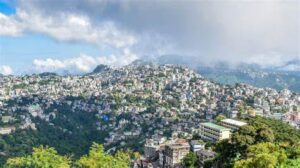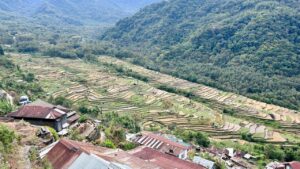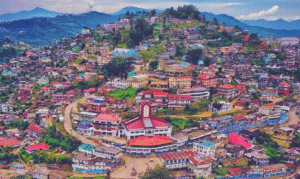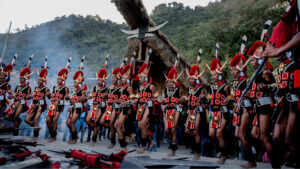In the culturally rich state of Manipur, where music, dance, and oral traditions form an integral part of its identity, the name Mayanglambam Mangangsana shines brightly as a guardian of the past and an innovator of the present. An acclaimed Pena artist, musician, and cultural revivalist, Mangangsana has played a pivotal role in resurrecting and popularizing the ancient Meitei musical tradition of the Pena—a traditional bowed mono-string instrument unique to Manipur.
With a profound dedication to his roots and an unshakeable passion for cultural preservation, Mangangsana is not merely a musician—he is a custodian of heritage, a teacher, and an ambassador of Manipuri indigenous knowledge systems. This blog explores the life, contributions, and legacy of Mayanglambam Mangangsana in keeping alive the sounds and stories of Manipur.
Early Life and Musical Roots
Born into a family with deep cultural roots, Mayanglambam Mangangsana was naturally drawn to the arts from a young age. He hails from Imphal, the capital of Manipur, where the traditional arts still thrive despite modern encroachments. Mangangsana’s father, the late Mayanglambam Gourakishore Sharma, was a renowned Pena master and a pivotal figure in his life. Gourakishore himself dedicated his life to the preservation of Pena and was a key contributor to its documentation and promotion.
Under his father’s guidance, Mangangsana began his training in the Pena tradition as a child. What started as a form of familial bonding slowly transformed into a spiritual and intellectual journey. By immersing himself in the age-old stories, rituals, and musical structures associated with the Pena, Mangangsana developed not just skill but a philosophical understanding of the instrument’s deeper cultural significance.
The Pena: More Than Just an Instrument
To understand Mangangsana’s journey, one must first understand the instrument he has so passionately revived. The Pena is not merely a musical instrument—it is a symbol of Manipuri heritage, often used in storytelling, ritual ceremonies, and community events. Traditionally played by Maibis (priestesses) and local bards, the Pena was used to transmit oral history, perform in ritualistic ceremonies, and accompany folk tales.
Crafted using bamboo, coconut shell, and animal hair, the Pena’s haunting, meditative sound is often associated with the sacred and the spiritual. By the late 20th century, however, the Pena faced extinction due to the growing dominance of Western instruments and modern musical trends. It was during this period of cultural erosion that Mangangsana rose to prominence.
The Cultural Revivalist
Mayanglambam Mangangsana’s mission has always been twofold: preserve the traditional Pena art form and innovate within it to ensure its relevance in contemporary society. He began by performing across Manipur, delivering solo concerts and storytelling sessions that combined music with oral narratives. These performances weren’t just recitals—they were immersive experiences that transported audiences into the cultural cosmos of the Meitei people.
Mangangsana also took his efforts beyond performance. Understanding that preservation begins with education, he started conducting workshops, giving lectures, and mentoring students in the Pena tradition. His goal was to demystify the instrument, make it more accessible, and create a sustainable model for its transmission.
Establishing Laihui – Centre for Indigenous Performing Arts
One of Mangangsana’s most enduring contributions to Manipur’s cultural landscape is the foundation of Laihui, a research and performance organization dedicated to the promotion and preservation of indigenous performing arts, especially the Pena tradition. Established in 1985 along with his father, Laihui became a beacon for young artists, researchers, and musicians seeking to reconnect with Manipuri culture.
Laihui doesn’t just teach students to play the Pena—it immerses them in a holistic understanding of its historical, philosophical, and spiritual dimensions. The institute emphasizes the oral traditions of the Meitei, exploring their mythologies, belief systems, and artistic expressions.
Laihui has conducted countless cultural exchange programs, hosted international artists, and worked with scholars to document endangered art forms. Through this institution, Mangangsana has transformed a near-forgotten instrument into a living, breathing symbol of cultural continuity.
National and International Recognition
Mayanglambam Mangangsana’s tireless efforts have not gone unnoticed. He has performed on prestigious national and international platforms, representing Manipuri indigenous music across countries such as Japan, South Korea, the United Kingdom, Germany, and the United States. Through his travels, he has introduced the Meitei Pena tradition to a global audience, promoting cultural diversity and cross-cultural appreciation.
In India, he has been featured in festivals organized by the Sangeet Natak Akademi, Indira Gandhi National Centre for the Arts, and Ziro Festival of Music, among others. His performances often blend traditional Pena music with contemporary elements, creating a fusion that appeals to younger generations while maintaining the soul of the tradition.
In recognition of his outstanding contribution to music and cultural preservation, Mangangsana has received several awards and accolades. These include:
- Ustad Bismillah Khan Yuva Puraskar from the Sangeet Natak Akademi
- Awards from various cultural bodies in Manipur and Northeast India
- Invitations as guest lecturer and performer at reputed institutions and universities
Education and Scholarly Work
Beyond being a performer, Mangangsana is also a scholar and researcher. He has contributed to several publications on Manipuri music, folklore, and indigenous traditions. He collaborates with ethnomusicologists, anthropologists, and historians to document the Pena tradition, ensuring its place in academic discourse.
His commitment to combining practice with theory has helped reposition indigenous art forms like Pena as serious areas of study within cultural studies and musicology. He is often invited to conduct talks, seminars, and demonstrations in institutions like Jawaharlal Nehru University, Manipur University, and international ethnomusicology forums.
Mentorship and Legacy Building
Perhaps the most profound measure of Mangangsana’s impact lies in the growing number of young Pena artists who consider him a mentor and guide. Through Laihui and other programs, Mangangsana has trained hundreds of students, many of whom now teach and perform across India and abroad.
By integrating technology, such as digital archives and online classes, he has also ensured that geographic distance is no barrier to cultural learning. His mentorship has sown the seeds for a future generation of artists who will carry forward the Pena tradition while experimenting with its possibilities.
Integrating Pena into Contemporary Culture
One of Mangangsana’s most innovative contributions is how he has adapted Pena music for contemporary expressions. Collaborating with folk, classical, and even experimental musicians, he has created new compositions that retain the essence of the Pena while speaking to modern audiences.
He has worked on theatrical productions, documentary scores, and multimedia installations where the Pena’s sound becomes a narrative device. This fusion-based approach has helped reframe the Pena not as a relic, but as a living instrument that can evolve with time.
Conclusion: A Guardian of Manipur’s Soul
In a rapidly globalizing world where cultural homogenization threatens unique traditions, Mayanglambam Mangangsana stands as a guardian of identity, memory, and music. His journey—from learning under his father’s guidance to becoming an international ambassador of Manipuri heritage—exemplifies the power of cultural resilience and artistic dedication.
Through performance, pedagogy, research, and activism, Mangangsana has not only saved the Pena from obscurity but has elevated it into a symbol of Meitei pride and pan-Northeast Indian identity. As Manipuri youth today look to reconnect with their cultural roots, it is mentors like Mangangsana who provide the roadmap.
By listening to the evocative strains of the Pena in Mangangsana’s hands, one doesn’t just hear music—they hear history, stories, rituals, and resistance. In every performance, he reaffirms that art is not merely for entertainment, but for remembrance and regeneration.






